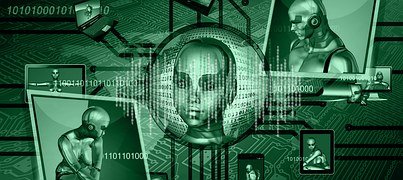Subcultures and Social Trends: The Transhumanists – The Singularity and Modern Cyborgs

It is estimated that somewhere around the year 2045, a technological singularity will occur- the point at which artificial intelligence outstrips human capacity; only it’s not quite the story as James Cameron portrayed it in his groundbreaking movie The Terminator. Rather, it would seem the singularity is closer to The Borg from the Star Trek Next Generation series.
The singularity’s slow march forward comes not in a rise of the machines, but in a world of surgically implanted LED lights to backlight tattoos, sub-dermal RFID chips and DIY wetware; all installed, not by licensed medical professionals, but rather by body modification enthusiasts at one of many body modification conferences around the world.
Welcome to the subculture of the Transhumanists.
A Brief History of Transhuanism

The phrase “Transhumanism” was first coined by the distinguished biologist, Julian Huxley, first director of UNESCO founder of the World Wildlife Fund and brother to the famous author, Aldous Huxley (author of A Brave New World) in his 1927 piece Religion Without Revelation. However, the concept of Transhumanism has existed since early humans attempted to extend beyond their physical and cognitive limitations. Stone tools, the bicycle, the gun, the aqualung, the space suit, the smart phone and the pacemaker; all of these creations are part and parcel of the Transhumanist subculture.
Transhumanist cultural ideals were first expressed through odysseys which spoke to ideas of immortality: the Epic of Gilgamesh in his quest for an herb growing at the bottom of the sea which provides immortality, or the Norse myth of Idun and her magic chest of apples which provided divine knowledge and eternal youth, or the myth of the Fountain of Youth. Idealistic expression turned into dark realization with the practice of eugenics in Sparta, where children deemed to have flaws or perceived deformities were left to die of exposure.
Modern day Transhumanist subculture can be dated back to the British geneticist J.B.S. Haldane in his 1923 essay, Daedaleus: Science and the Future where Haldane suggested the future applications of science and genetics would yield tremendous benefit to humans, and J.D. Bernal in his 1929 essay, The World, The Flesh, and the Devil, which speculated on the great benefits of space colonization and bionic implants to the human condition.
Fast forward to the present day world of the Do-It-Yourself Cyborg and the biohacker; where Transhumanism takes a more sci-fi, dystopian aura as people are creating and using hardware to upgrade their bodies, without waiting for the corporate development cycle to complete or the government authorities to regulate.
What Exactly is a Transhumanist?

“A wearable device is just one more thing to manage during the day. I don’t think people will want to deck themselves out with all that in the future… large, cumbersome and not exactly fashionable… Samsung and Apple aren’t blind to what we’re doing. Somewhere in the bowels of these companies are people thinking about implantables.”
One common vein of Transhumanism is the concept of a new, intelligent species evolved from humanity by way of cognitive and/or biomechanical enhancement, which will eventually either supplant or supersede the current human species. It is a distinct focus on the application of technology to the improvement of human bodies at the individual level.
In America and across the world, a dedicated amateur community of Transhumanists have been developing wetware technology and experimenting with this technology, on themselves, for the past several years. They refer to themselves as “grinders” and “biohackers.” Sometimes it starts with a vegetable peeler, an RFID chip and a dream. Sometimes that dream encounters minor setbacks such as sepsis and an extended stay in the hospital.
”…at a conference in Berlin in December 2010, Anonym described her first foray into grinding thusly: ‘I sat down in my kitchen with a vegetable peeler, I shit you not, and I decided to put things in my hands. … The first time I ever sat down, it went horribly, horribly wrong. The whole thing went septic, and I put myself in the hospital for two weeks.’ For most people, that would be ample motivation to swear off grinding for good. But Anonym learned lessons and kept at it, successfully implanting an RFID chip before moving on to other implants…. Her exploits, in turn, inspired others.”
In the grinder community, sensory expansion appears to be where the early biohack energy is being focused. For example, large amounts of nerve endings are jammed into the fingertips, allowing humans to experience a very broad array of sensory information. Grinders would extend this sensory array spectrum by embedding super magnets from cellular phones into the tips of their fingers, so their fingers vibrate in the presence of electrical current. As synthesia develops, new neural pathway formation from these new sensations over time causes an almost sixth sense to appear, where one can intuitively sense what is giving off electromagnetic energy in a room.
Grinders are not limited to (and choose not to limit themselves to) super magnets to embed into their fingers, they have an entire array of sensors and wiring to embed which can created that sixth sense synthesia for things such as heat, radio signals, wifi signals, etc., and a number of other places on their body to embed the wetware.
”In Barcelona, a nonprofit called the Cyborg Foundation is pushing a more artistic (and less cringe-inducing) vision of sensory extension. It was founded by Neil Harbisson, an artist and musician who was born with achromatopsia, the inability to see colors. Since 2004, Harbisson has worn a device he calls the eyeborg, a head-mounted camera that translates colors into soundwaves and pipes them into his head via bone conduction. Today Harbisson “hears” colors, including some beyond the visible spectrum. “My favorite color is infrared,” he told me, because the sound it produces is less high-pitched.”
The media is rife with stories and editorials about the Transhumanist subculture:
- Motherboard Vice (http://motherboard.vice.com/blog/the-diy-cyborg)
- Scientific American (http://www.scientificamerican.com/article/merging-of-mind-and-machine/)
- Huffington Post (http://www.huffingtonpost.com/news/transhumanism/)
- TechCrunch (https://techcrunch.com/2016/08/26/the-ethics-of-transhumanism/)
One question often presented to Transhumanists is the question, “why would you want to feel magnetic fields, or radio signals or wifi signals? It’s not something you need.”
The Transhumanist counter would be, “what if you lost the ability to taste? You don’t need it to survive.”
Capitalism and the Transhumanist Subculture

The marketplace for Do-It –Yourself sub-dermal wetware is much more broad, diverse and available than one would think at first glance and a broad array of Transhumanism conferences and meetups exist as well.
- Grindhouse Wetware (http://www.grindhousewetware.com/)
- Dangerous Things (https://dangerousthings.com/)
- Cyborg Foundation (http://www.cyborgfoundation.com/)
- BodyHacking Con (https://bodyhackingcon.com/)
Generally speaking, most Transhumanist conventions run alongside or are part of body modification conferences. One major reason for this is because the sub-dermal implants are not medically approved devices, and as a consequence, surgeons are not permitted to implant these unapproved medical devices into the Transhumanists.
Enter the body modification enthusiasts, who fill the void of the board certified surgeon, complete with their own tools of the trade. Since these body modification grinders are not board certified surgeons, one tool which is never present is anesthetic, but they assure there are some amazing things one can do with some ice and strong convictions.
While very extreme to most humans, this subculture continues to push forward, to build new wetware, to test it and perfect it on themselves and attempts to evolve the human species into a more Borg-like perfect existence.
”There exists a small group of passionate grinders and biohackers who, despite having limited resources and few evangelists, tinker, test, and collaborate on a daily basis because they see transhumanism as a noble cause and a method to uplift mankind and that they have ambitious ideas for achieving this using affordable and existing technology they believe may change the world.”
References
Wikipedia. “Transhumanism.” Np. September 15, 2016. https://en.wikipedia.org/wiki/Transhumanism
Kurzweil, Ray. “The Coming Merging of Mind and Machine.” Scientific American. March 23, 2009. http://www.scientificamerican.com/article/merging-of-mind-and-machine/
House, Arthur. “The Real Cyborgs.” The Telegraph. October 20, 2014. http://s.telegraph.co.uk/graphics/projects/the-future-is-android/
Dvorsky, George. “”The Latest Trend Among Biohackers is Implanting LED Lights Beneath Your Skin.” Gizmodo. November 10, 2015. http://gizmodo.com/the-latest-trend-among-biohackers-is-implanting-led-lig-1741697381?utm_campaign=socialflow_gizmodo_facebook&utm_source=gizmodo_facebook&utm_medium=socialflow
Scheinman, Ted. “Transhumanists.” Pacific Standards. November 6, 2015. https://psmag.com/transhumanists-2b8cbc8cde97#.6707f1tph
Hoppenstead, Max. “The DIY Cyborg.” Motherboard Vice. October 13, 2013. http://motherboard.vice.com/blog/the-diy-cyborg
Oremus, Will. “Choose Your Own Sixth Sense.” The Slate. March 14, 2013. http://www.slate.com/articles/technology/superman/2013/03/cyborgs_grinders_and_body_hackers_diy_tools_for_adding_sensory_perceptions.html
Istvan, Zoltan. “Interview with Transhumanist Biohacker Rich Lee.” Psychology Today. July 6, 2014. https://www.psychologytoday.com/blog/the-transhumanist-philosopher/201407/interview-transhumanist-biohacker-rich-lee
Great article, a real jewel for a sci-fi writer. However, I prefer to modify myself with more natural ways - physical activity and vegetarianism. The results are slow but visible.
I tend to agree on that one. The part about the scottish girl using a vegetable peeler to put the wetware in and getting sepsis was pretty intense, but finding three links to real life wetware marketplaces and one to a body hack body modification conference truthfully had me stunned. As I have said in my previous pieces, it's amazing what we as humans will do for acceptance. Subcultures and Social Trends is a series so please follow if you'd like the next installments in your feed.
Here you can find some more answers about what transhumanism actually is and what different sub categories of transhumanist thinking/philosophy exist: https://steemit.com/transhumanism/@mdeltaone/what-is-transhumanism
if a singularity happens, it will be so utterly incomprehensible that rather than comparing it to the mundane, almost entirely recognizably human, borg, i would sooner compare a brick to a hyper-intelligent fireworks display. i would guess it will be closer to a nano-swarm transforming all matter within reach into consciously intelligent computational structures or blazing radiation storms of self aware, higher dimensional, energetic wave complexes, making this trivial meat-machine fetishism look like the several billion year dark age before we crawled out of the slime. this cyborg stuff has been the dream of the protoplasm-centric dullards since they invented sliced bread and thought it was pretty neat. if a singularity happens, we are not all going to turn into edward scissorhands. we will either transcend to a different form or cease to exist as something else does.
I would suggest to you that the rise of the singularity, much like the rise of humans from single celled organisms, will be an evolution which follows a geometric rate of development. Based upon the information I have read, we are at the very early stages of this path. I many ways, kids at BMX (Body Modification) Conferences with RFID Chips in their fingers and LED lights embedded under their tattoos are representative of the early adopter phase on a very early evolutionary path.
I agree with your point about what a true, mature singularity looks like will make even the idea of cyborgs seem trivial, much like the difference between modern medicine and witch doctors. However I disagree with your point that what biohackers and grinders are doing today is in no way related to how a singularity will unfold.
i didn't say it was in no way related, but it is not, i repeat, not evolution. this is tool making and tool use. we do already have the basics for an understanding for self directed genetic alterations. look into epigenetics, if you like. we will learn to, or already have, speed this process along. once we get over this present, archaic genetic modification model, we will begin to be able to do things mostly unthinkable now. we are beginning to make great leaps forward in understanding how we interact genetically and epigenetically with microbes. some places to start would be, quorum sensing, plasmid mutation, viral DNA transfer and a new gene-mod method called crispr. an overall geometric rate of progression is the usual, with modifiers, when dealing with tech advancement. advancement, of the tool use variety, will enormously increase our ability to direct the actual evolution of the biological aspect. this is now taking place in the form of "big data", and the 'ware to take advantage of it.
image:blog.newrelic.com
so fascinating...
When I fist looked into the subculture, it was nothing of interest until I started learning about the DIY wetware, what it does and the body modification enthusiasts turned surgeons. I think it's one of my most favorite subcultures to date.
There have been some interesting scifi concerning wetware over the years.
I will agree with that. However, real life grinders are something I did not expect to encounter in my lifetime.
I really appreciate the thouroughness that went into writing this article! With references great work OP!
@plcoky7, thanks for taking the time to read the article and commenting. Th Subculture and Social Trends is a series I have been working on for a bit and this is the sixth installment in the series. I try to present the subculture in an objective almost documentary-style way to inform the reader, rather than editorializing a viewpoint to persuade the reader with a specific viewpoint. I have always been fascinated by what human beings will do to find social acceptance.
If you enjoyed the read, I would encourage you to check out some of the earlier installments on my blog and follow along for the future installments in the series.